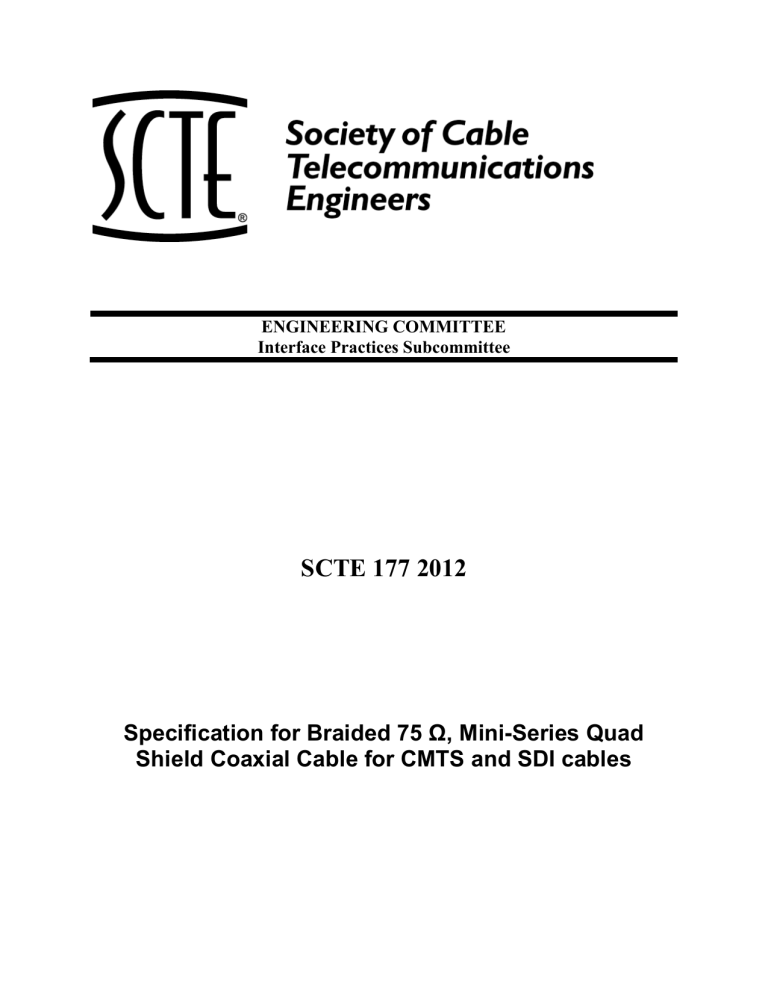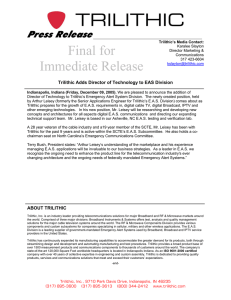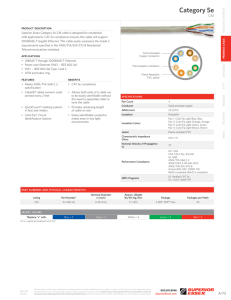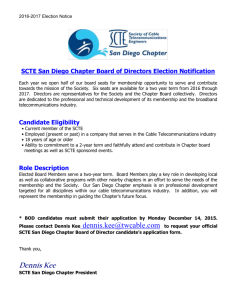SCTE 177 2012

ENGINEERING COMMITTEE
Interface Practices Subcommittee
SCTE 177 2012
Specification for Braided 75 Ω, Mini-Series Quad
Shield Coaxial Cable for CMTS and SDI cables
NOTICE
The Society of Cable Telecommunications Engineers (SCTE) Standards are intended to serve the public interest by providing specifications, test methods and procedures that promote uniformity of product, interchangeability and ultimately the long term reliability of broadband communications facilities. These documents shall not in any way preclude any member or nonmember of SCTE from manufacturing or selling products not conforming to such documents, nor shall the existence of such standards preclude their voluntary use by those other than SCTE members, whether used domestically or internationally.
SCTE assumes no obligations or liability whatsoever to any party who may adopt the Standards.
Such adopting party assumes all risks associated with adoption of these Standards, and accepts full responsibility for any damage and/or claims arising from the adoption of such Standards.
Attention is called to the possibility that implementation of this standard may require the use of subject matter covered by patent rights. By publication of this standard, no position is taken with respect to the existence or validity of any patent rights in connection therewith. SCTE shall not be responsible for identifying patents for which a license may be required or for conducting inquiries into the legal validity or scope of those patents that are brought to its attention.
Patent holders who believe that they hold patents which are essential to the implementation of this standard have been requested to provide information about those patents and any related licensing terms and conditions. Any such declarations made before or after publication of this document are available on the SCTE web site at http://www.scte.org
.
All Rights Reserved
© Society of Cable Telecommunications Engineers, Inc. 2012
140 Philips Road
Exton, PA 19341 i
TABLE OF CONTENTS
1.0 INTRODUCTION .............................................................................................................. 1
2.0 SCOPE ................................................................................................................................ 1
3.0 CENTER CONDUCTOR ................................................................................................... 1
4.0 DIELECTRIC ..................................................................................................................... 2
5.0 SHIELD CONSTRUCTION .............................................................................................. 2
6.0 JACKET .............................................................................................................................. 3
7.0 FINISHED PRODUCT TESTS .......................................................................................... 3
8.0 NORMATIVE REFERENCES .......................................................................................... 6
9.0 INFORMATIVE REFERENCES ....................................................................................... 7
10.0 GLOSSARY ....................................................................................................................... 8 ii
1.0
INTRODUCTION
This specification applies to flexible 75-ohm, braided, mini-series quad shield coaxial cable for use in CMTS and SDI applications.
When reference to other regulations or specifications is made, the user should adhere to the latest revision of the regulation or specification.
2.0
SCOPE
2.1
This specification defines the required performance with regards to electrical and mechanical properties of 75-ohm, braided, mini-series quad shield coaxial cable for CMTS and SDI applications.
2.2
These cables are used in the transmission of RF signals and power for voice, data and video applications.
2.3
Cables meeting the requirements within this standard are for use with interior applications. Use within exterior applications is outside the scope and requirements of this document.
3.0
CENTER CONDUCTOR
3.1
Center conductor dimension shall be 0.0226
±
1% inches (0.574 mm
±
1%).
3.2
Solid copper or copper clad steel shall be specified.
3.3
Minimum break strength (MBS) of the solid copper center conductor shall be determined by multiplying the minimum cross sectional area by 32,000 psi (221
MPa). MBS for 0.0226” solid copper conductor equals 13lbf (57 N).
3.4
Minimum break strength (MBS) of the copper clad steel center conductor shall be determined by multiplying the minimum cross sectional area by 95,000 psi (655
MPa). MBS for 0.0226” copper clad steel conductor equals 38lbf (169 N).
3.5
The center conductor electrical conductivity shall be 40 percent IACS minimum.
3.6
Maximum DC resistance shall be measured per ANSI/SCTE 44, and shall be 51.0 ohms/1000 ft (167 ohms/km).
1
4.0
DIELECTRIC
4.1
The dielectric shall contain a stabilization package to meet the requirements of section 6.1.3 Thermal Oxidative Stability (TOS).
4.2
Unless otherwise specified, polyethylene materials for the dielectric shall meet all applicable requirements of ASTM D 1248 and requirements of this document.
4.3
Nominal Dielectric Diameter – 0.100 inch (2.54 mm).
5.0
SHIELD CONSTRUCTION
5.1
QUADSHIELD
5.1.1
INNER LAMINATED SHIELDING TAPE (LST)
5.1.1.1
The first outer conductor shall be a LST bonded to the dielectric and to itself at the tape overlap.
5.1.2
5.1.1.2
On the finished product, the LST shall overlap the dielectric circumference by a minimum of 18 percent.
5.1.1.3
The LST shall be applied longitudinally to the dielectric and shall be free of creases or twists over the entire length.
5.1.1.4
The average core diameter shall be determined by measuring the diameter over the LST in the finished product as described in ANSI/SCTE 31. Average core diameter – 0.107 ± 0.003 inches (2.72 ± 0.08 mm)
5.1.1.5
Core ovality shall be determined by subtracting the measured minimum diameter from the measured maximum diameter over the LST in the finished product. Core ovality maximum – 0.010 inches (0.254mm)
INNER BRAID WIRES
5.1.2.1
The braiding wire shall be tin copper wire consisting of 36
AWG (0.005±0.0003 inches, 0.13±0.08 mm) maximum.
5.1.2.2
Minimum tensile strength for individual strands of tinned copper braid wire shall comply with ASTM B33 latest revision.
5.1.2.3
Braid coverage over the first outer conductor shall be a minimum of 64 percent. The braid coverage shall be determined by ANSI/SCTE 51.
2
5.1.3
5.1.4
OUTER LAMINATED SHIELDING TAPE (LST)
5.1.3.1
A LST shall be applied over the braid wires specified in section 5.1.2.
5.1.3.2
The LST shall be constructed of two aluminum foils laminated to a central strength member.
5.1.3.3
The outer LST shall be applied longitudinally over the second outer conductor with an overlap of 18% minimum to 35% maximum and shall be free of creases, twists and discontinuities over the entire length.
OUTER BRAID WIRES
5.1.4.1
The braiding wire shall be tin copper wire consisting of 36
AWG (0.005±0.0003 inches, 0.13±0.08 mm) maximum.
5.1.4.2
The individual strands of tinned copper braid wire shall conform to ASTM B33 latest revision.
5.1.4.3
Braid coverage over the LST shall be sufficient to comply with screen attenuation requirements specified in section
7.2.6.
6.0
JACKET
6.1
Flame retardant polyvinyl chloride (PVC) compound shall be used in the composition of the jacket.
6.2
The jacket material shall be UV stable after 720 hours, as defined in UL 1581, paragraph 1200 .
6.3
The diameter over the jacket shall be 0.184 ± 0.005 inches (4.67±0.18 mm) when measured as described in ANSI/SCTE 33.
7.0
FINISHED PRODUCT TESTS
7.1
Mechanical
7.1.1
The cable shall be flex tested in accordance with IEC 61196-1-314 and pass all electrical requirements outlined in section 7.2.6.
3
7.1.2
7.1.1.1
Cable shall be subjected to 5 cycles.
7.1.1.2
Diameter of pulleys shall be 3.750 inches (95.25 mm) maximum.
7.1.1.3
Cycle speed shall be ≤3.281 ft/s (1 m/s).
7.1.1.4
Test temperature shall be 68 degrees Fahrenheit (20 degrees Celsius).
7.1.1.5
Cable length shall be 72 inches (182.9 cm).
7.1.1.6
There shall be a minimum 2.2 lb (1 kg) tension applied to each end of the cable while undergoing testing.
Jacket longitudinal shrinkage shall be no more than 5 percent of the length under test and tested per ANSI/SCTE 88.
7.1.3
Thermal Oxidative Stability
To ensure the desired life expectancy of the dielectric insulation, determine its Oxidative Induction Time (OIT) before and after aging at 194
°
F (90
°
C) for 14 days by measuring OIT according to ASTM
D 4565, Section 17. The test utilizes insulation removed from the completed cable and tested at 356
°
F
±
0.5
°
F (180
°
C
±
0.3
°
C).
Requirements for OIT – Initial: 20 minutes minimum, after aging:
70 percent of initial value.
7.1.4
7.1.5
If required, the insertion force to install a connector onto a cable may be measured as described in ANSI/SCTE 73.
Center conductor to dielectric bond strength shall be a minimum of 3 lbs (1.36kg) and measured per ANSI/SCTE 59.
7.2
Electrical
7.2.1
Velocity of Propagation (Vp) shall be 82 percent minimum when measured per ANSI/SCTE 49.
7.2.2
7.2.3
Impedance shall be 75 ± 3 ohms per ANSI/SCTE 66.
The cable minimum ampacity in both conductors shall be 3 ampere at
140°F (60°C) when determined per ANSI/SCTE 32.
4
7.2.4
7.2.5
7.2.6
7.2.7
Minimum structural return loss shall be 20 dB in the frequency range
5-2250 MHz and 15 dB in the frequency range 2.25-3 GHz per
ANSI/SCTE 03 when measured on 200 ft sections. Performance is irrespective of packaging.
When tested in accordance with ANSI/SCTE 44, at 68°F (20°C), the maximum DC loop resistance shall be 58.2 Ohms per 1000 ft (191
Ohms per km).
The cable shall be tested for screen attenuation (shielding effectiveness) in accordance with IEC 62153-4-4. The cable shall meet a minimum of 95dB in the frequency range of 5-1002 MHz, shall meet a minimum of 85dB in the frequency range of 1-2 GHz, and shall meet a minimum of 75dB in the frequency range of 2-3
GHz. Alternate test method maybe used per ANSI/SCTE 48-3.
The maximum attenuation for all construction types shall be as specified in Table 6.2 per ANSI/SCTE 47.
Frequency
(MHz) dB/100ft dB/100m
5
55
211
250
270
300
330
350
400
450
500
550
600
750
870
1000
1500
2000
2250
3000
1.00
2.82
5.30
5.72
5.94
6.26
6.56
6.75
7.25
7.70
8.11
8.54
8.92
10.01
10.79
11.62
14.37
16.73
17.82
20.78
3.28
9.25
17.39
18.77
19.49
20.54
21.52
22.15
23.79
25.26
26.61
28.02
29.27
32.84
35.40
38.13
47.15
54.89
58.46
68.18
Table 6.2 -
Maximum Attenuation at 68˚F (20˚C)
5
7.2.8
7.2.9
The dielectric between inner conductor and outer conductor of the cable shall withstand without breakdown, for one minute, a voltage of
1000V rms at a frequency of 60 Hz, or the equivalent DC voltage at 1 milliamp/100 ft leakage detection when tested at 68º F (20 Cº) per
ANSI/SCTE 108.
The finished cable shall be listed as being suitable for use in NEC
Article 800 CMR locations and marked accordingly.
8.0
NORMATIVE REFERENCES
The following documents contain provisions that, through reference in this text, constitute provisions of this standard. At the time of publication, the editions indicated were valid. All standards are subject to revision, and parties to agreement based on this standard are encouraged to investigate the possibility of applying the most recent edition of the documents listed below.
1.
ANSI/SCTE 03 2008: Test Method for Coaxial Cable Structural Return Loss.
2.
ANSI/SCTE 31 2007: Test Method for Measuring Diameter Over Core.
3.
ANSI/SCTE 32 2009: Ampacity of Coaxial Telecommunications Cables.
4.
ANSI/SCTE 33 2010: Test Method for Diameter of Drop Cable.
5.
ANSI/SCTE 44 2010: Test Method for DC Loop Resistance
6.
ANSI/SCTE 47 2007: Test Method for Coaxial Cable Attenuation.
7.
ANSI/SCTE 48-3 2011: Test Procedure for Measuring Shielding Effectiveness of
Braided Coaxial Drop Cable Using the GTEM Cell
8.
ANSI/SCTE 49 2011: Test Method for Velocity of Propagation.
9.
ANSI/SCTE 51 2007: Test Method for Determining Drop Cable Braid Coverage.
10.
ANSI/SCTE 59 2007: Test Method for Drop Cable Center Conductor Bond to
Dielectric
11.
ANSI/SCTE 66 2008: Test Method for Coaxial Cable Impedance.
12.
ANSI/SCTE 73 2002R2007: Test Method for Insertion Force of Connector to Drop
Cable Interface.
13.
ANSI/SCTE 88 2007: Test Method for Polyethylene Jacket Longitudinal Shrinkage.
6
14.
ANSI/SCTE 108 2006: Test Method for Dielectric Strength Withstand of Coaxial
Cable.
15.
ANSI/UL1581-2001: Reference Standard for Electrical Wires, Cables and Flexible
Cords.
16.
ASTM D1248-05: Standard Specification for Polyethylene Plastics Extrusion
Materials For Wire and Cable.
17.
ASTM D 4565-99(2004): Physical and Environmental Performance Properties of
Insulations and Jackets for Telecommunications Wire and Cable.
18.
ASTM B33-04: Standard Specification for Tin-Coated Soft or Annealed Copper Wire for Electrical Purposes
19.
IEC 61196-1-314: Coaxial communication cables - Part 1-314: Mechanical test methods - Test for bending
20.
IEC 62153-4-4: Metallic communication cable test methods - Part 4-4:
Electromagnetic compatibility (EMC) - Shielded screening attenuation, test method for measuring of the screening attenuation a s
up to and above 3 GHz
21.
NEC
®
-2011 Article 800: Communication Circuits.
9.0
INFORMATIVE REFERENCES
The following documents may provide valuable information to the reader but are not required when complying with this standard.
1.
ANSI/SCTE 69 2007: Test Method for Moisture Inhibitor Corrosion Resistance.
2.
ANSI/SCTE 166 2010: Flexure Method for Drop Cable Conditioning
3.
ASTM B1-01(2007): Standard Specification for Hard-Drawn Copper Wire.
4.
ASTM B193-02(2008): Resistivity of Electrical Conductive Materials.
5.
ASTM B3-01(2007): Standard Specification for Soft or Annealed Copper Wire.
6.
ASTM B566-04a: Standard Specification for Copper-Clad Aluminum Wire.
7.
Jones Dictionary: Cable Television Terminology 3rd Edition.
8.
NFPA-70-2-11 Article 820: Community Antenna Television and Radio Distribution
Systems.
7
9.
NEC
®
-2011 Article 830: Network-Powered Broadband Communications Systems.
10.
IEEE: Standard Dictionary of Electrical and Electronic Terms
10.0
GLOSSARY
Attenuation: The decrease in magnitude of a wave as it travels through any transmitting medium, such as cable or circuitry. It is the difference between transmitted and received power.
Coaxial Cable: A type of cable used for broadband data and cable systems, composed of a center conductor, insulating dielectric, conductive shield and optional protective covering.
Conductivity: The ability of a material to allow electrons to flow, measured by the current per unit of voltage applied. It is the reciprocal of resistivity.
Core Ovality: The difference between the minimum and maximum dimensions over the first laminated shield tape.
CMTS: Cable Modem Termination System
DC Resistance: The opposition a conductive material offers to current flow, measured in ohms.
DC Loop Resistance: A resistance measurement of the center conductor and outer conductor when connected in series (measured in ohms/1000 feet or ohms/km).
Dielectric: A nonconductive insulator material between the center conductor and outer conductor of coaxial cable.
Dielectric Withstand: The ability of the drop cable insulation to withstand a minimum specified voltage.
Impedance: The total opposition a circuit, cable or component offers to alternating current flow. It includes both resistance and reactance and is generally expressed in ohms and designated by the symbol Z.
IACS: International Annealed Copper Standard (IACS) set the conductivity of copper at
100% in 1913 and was adopted by the International Electro-Technical Commission
(IEC). The conductivity of an electrical conductor is expressed in units of a percentage of IACS.
SDI: Serial Digital Interface
8


